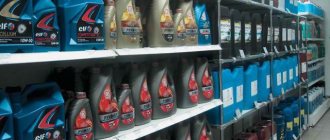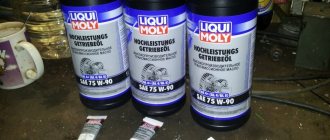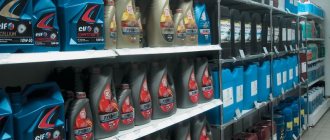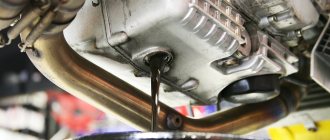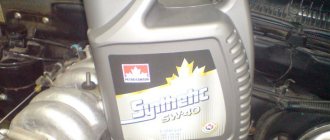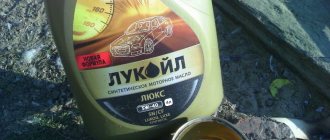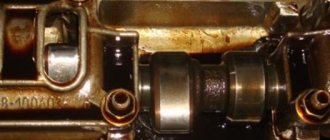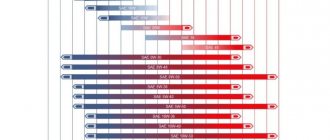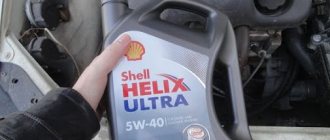- home
- Brands
- Chevrolet
07.11.2020
Chevrolet Niva is a compact cross-country passenger car. It has a design and component base from the Soviet Niva model of 1977 - it has permanent all-wheel drive, a transfer gearbox and a 1.7-liter 80-horsepower engine. The gearbox is five-speed manual. From 2004 to 2008, the car repeatedly became the best-selling SUV on the Russian market. Moreover, in 2009 it was awarded the “SUV of the Year” award. The closest competitors of the Chevrolet Niva include Renault Duster, Cherry Tiggo, Daihatsu Terios, Suzuki Vitara and other budget crossovers.
Chevrolet Niva filling volumes
Some people use very thin oils 0 – 40, but they cost much more and won’t make much of a difference.
If the car engine does not have hydraulic compensators, you can use 10 - 40 regardless of the season, and in the case of hydraulic compensators, fill in 5 - 40. The number of these elements in each car may vary. In addition, it is important to have a clear understanding of the location, types, engine and transmission oil used, types of lubricants and fluids.
- After all, Chevrolet Niva filling tanks must be filled taking into account the plant’s recommendations so that all systems can fully operate.
- Video
FILLING CAPACITIES
| Refillable system | Volume, l |
| Fuel tank (including reserve) | 42 (65*) |
| Engine cooling system (including interior heating system) | 10,7 |
| Engine lubrication system (including oil filter) | 3,75 |
| Gearbox housing | 1,6 |
| Rear axle housing | 1,3 |
| Steering gear housing | 0,18 |
| Transfer case housing | 0,79 |
| Front axle housing | 1,15 |
| Hydraulic clutch system | 0,2 |
| Hydraulic brake system | 0,535 |
| Windshield and headlight washer reservoir | 2,8 |
| Rear window washer reservoir | 2,0 |
| Power steering reservoir | 1,7 |
* For VAZ-2131 cars and its modifications.
| Refueling or lubrication point | Quantity, l | Name of materials |
| Fuel tank | 42 | Motor gasoline with octane number 91–93, 95* |
| Engine cooling system including interior heating system | 10,7 | Coolant with a freezing point no higher than –40°C |
| Engine lubrication system, including oil filter, at ambient temperature: | 3,75 | Motor oils (with API quality level: SG, SH, SJ) |
| from –20° to 45°С | SAE 15W-40 | |
| from –25° to 35°С | SAE 10W-30 | |
| from –25° to 45°С | SAE 10W-40 | |
| from –30° to 35°С | SAE 5W-30 | |
| from –30° to 45°С | SAE 5W-40 | |
| Gearbox housing | 1,35 | Gear oils with quality level according to API GL-5 and viscosity 75W-90 |
| Transfer case housing | 0,75 | |
| Front axle housing | 1, 15 | |
| Rear axle housing | 1,3 | |
| Steering gear housing | 0, 18 | Gear oil 75W-90 |
| Hydraulic clutch release system Hydraulic brake system | 0,2 0,515 | Brake fluid DOT-3, -4 |
| Windshield washer reservoir Tailgate washer reservoir | 2,0 (5,0) | A mixture of water and windshield washer fluid |
| Starter drive drive ring | — | Litol-24 lubricant or imported analogues |
| Front wheel bearings | — | Litol-24 lubricant or imported analogues |
| Cardan joint cross bearings | — | Lubricant Fiol-2U, No. 158 or imported analogues |
| Front propeller shaft spline | — | Lubricant Fiol-1, CV joint-4 or imported analogues |
| Door limiters | — | Grease Shrus-4 |
| Seat moving slides | Fiol-1 lubricant or imported analogues | |
| Tie rod joints and front suspension ball pins | — | ShRB-4 lubricant or imported analogues |
| Battery leads and terminals, door keyholes | Automatic lubricant VTV-1 in aerosol packaging, CIATIM-201, -221, Litol-24 or imported analogues | |
| Door locks | — | Fiol-1 lubricant or imported analogues |
| Rear brake pressure regulator | — | Lubricant DT-1 or imported analogues |
*For vehicles with fuel injection system equipped with an exhaust gas converter
- FILLING CAPACITIES, OILS AND LIQUIDS.
- Oils and liquids
- Motor gasoline with octane number 93, 95**
- Engine cooling system
- (including interior heating system)
- Coolant with a freezing point no higher than –40°C
- Latest recommendation from AvtoVAZ
- Sintec Antifreeze Lux G12
- Engine lubrication system
- (including oil filter)
- Motor oils (with API quality level: SG, SH, SJ, SL,SM, SN)
- Gearbox housing
- Gear oils with quality level according to API GL-5 and viscosity 75W-90
- Rear axle housing
- Steering gear housing
- Transfer case housing
- Front axle housing
- Hydraulic clutch system
- DOT-4 brake fluid
- Hydraulic brake system
- Windshield and headlight washer reservoir
- A mixture of water and windshield washer fluid
- Rear window washer reservoir
- Power steering reservoir
- Fluid for refilling the hydraulic steering system Pentosin SHF11S
- * For VAZ-2131 cars and its modifications.
- **For vehicles with fuel injection system equipped with an exhaust gas converter
Also interesting: How to tighten or replace the handbrake on a Chevrolet Niva.
This recording is more for myself, but maybe it will be useful for someone else. Since after the purchase I only changed the oil in the engine, and it’s not at all clear what and how much in the transmission, I’m thinking about changing the oils in the gearbox, transfer case and axles. It would be good to know what kind of transmission oil to fill in to reduce the howling of the transfer case.
Fuel tank 58.
0 l Engine cooling system 8.0 l Engine lubrication system 3.75 l Gearbox housing 1.6 l Transfer case housing 0.79 l Front axle housing 1.15 l Rear axle housing 1.3 l Brake hydraulic system 0.5 l Clutch release hydraulic system 0.15 Windshield washer reservoir 5.0 l Tailgate washer reservoir 2.0 l Front shock absorber 0.15 l Rear shock absorber 0.215 l Power steering 1.7 l Air conditioning: refrigerant 0.650 kg
Conditioner: oil 0.22 l
- Places for lubrication, filling, processing
- Motor oils type SUPER (classification according to SAE; API) Engine lubrication system Viscosity class according to SAE: 5W-30: from –25 to 20 С5W-40: from –25 to 35 С10W-30: from -20 to 30 С10W -40: from -20 to 35 С15W-40: from –15 to 45 С20W-40: from –10 to 45 Level of performance properties: according to API SG, SH, SJ according to ASEA A2
- according to CCMC G3, G4
- Transmission oils (classification according to SAE; API) Gearbox, Transfer case Viscosity grade according to SAE: 75 W-90; 80 W-85; 80 W-90; Level of performance properties: according to API: GL-4 or universal: GL-4/ GL-5 Front axle, Rear axle, Steering gear Viscosity grade according to SAE: 80 W-90; 85 W-90; Level of performance properties: according to API: GL-5 or universal: GL-4/ GL-5
- Power steering: Pentosin Hidraulik Fluid CHF11S VW52137
How to avoid falling asleep while driving on the highway
GreasesFront wheel drive joints CV joints-4M, SPECTROL CV joints MoS2 TU 0254-001-0014882Front suspension ball joints, Steering rod joints ShRB-4 TU 38.
USSR-201-143 Joints for cardan shafts Litin 2 TU 0254-311-00148820 Splined joints for cardan shafts 158 TU 38.
Dowcorning
Pressure regulator DT-1 TU 38-USSR-201-116
Brake and clutch hydraulic drive system Brake fluids type DOT-4 SAE J 1703, FMSS116
In this article we will talk about how to change the oil in the gearbox, transfer case and axles of a Chevrolet Niva. The use of high-quality lubricants for vehicles plays an important role in the operation of any car. The most common process for proper vehicle operation is the oil change process. It is possible to change the oil yourself, without resorting to the help of auto service employees, while significantly saving money.
Choosing engine oil is a responsible task on which the service life of the power plant depends. This procedure is no less important than the oil change process itself. Oil should be selected according to the parameters and tolerances specified in the operating instructions.
You cannot make a mistake in your choice, as this mistake can result in a serious technical breakdown, and incompatible oil can cause a major overhaul of the engine.
In this article, using the example of the popular Chevrolet Niva SUV, we will pay attention to the most important parameters of motor oil, and also consider the best brands of oils and how much oil should be filled.
Lubricants consist of a base (base) and additives. Their chemical and physical properties depend on the composition and origin of these components.
According to the method of manufacturing the base, the transmission is divided into three types:
- Mineral is a product remaining after the distillation of oil in the production of diesel fuel and gasoline. Includes heavy fractions of hydrocarbons and contains large amounts of sulfur. Its properties are determined by naphthenes, aromatics and paraffins. The oil entering oil refineries differs in its composition. This does not allow achieving stable mixture proportions. Therefore, the final parameters are adjusted with additives. Under the influence of temperature, heavy fractions of hydrocarbons disintegrate, and additives oxidize and lose their properties. This oil has to be changed more often. Another disadvantage of “mineral water” is that oxidation products settle on parts.
- The synthetic base is artificially created from the desired hydrocarbons. Thanks to this, it is possible to obtain a product with predictable viscosity values without the use of additives. Additives are used only to improve the lubricating and antioxidant properties of the transmission.
- Semi-synthetic oils are created on the basis of a mixture of mineral and synthetic bases (at least 30% of the latter is used). This approach allows you to reduce the number of additives that change viscosity.
And also interesting: We are installing an engine on a Niva from a foreign car. It's worth it "
Synthetic gear oil differs from mineral and semi-synthetic oil in that its viscosity changes less with temperature changes. This reduces wear on transmission parts during winter operation of the Chevrolet Niva. But “synthetics”, due to their greater fluidity, seep through worn gearbox seals more easily.
However, the main characteristic of a lubricant is viscosity. This is what is indicated in the operating instructions. The manufacturing company recommends filling in the following types of gear oils (according to SAE):
- Transfer case and gearbox - 75W-90, 80W-85, 80W-90.
- Drive axles (front and rear) - 80W-90, 85W90.
Therefore, API GL4 and GL4/GL5 must be poured into the gearbox (gearbox), and GL4/GL5 and GL5 into the axles and transfer case.
There are dozens of gear oil brands on the market. The most famous imported ones are Castrol, Liqui Moly, Mobile, Shell, and the most famous domestic ones are Lukoil and Rosneft.
Greases
| Lubricant brand | Manufacturer | Regulatory document |
| Vaseline technical VTV-1 | JSC "Rikos", Rostov-on-Don | TU 38.301-40-21 |
| Vaseline technical ONMZ VTV-1 | JSC "Neftemaslozavod", Orenburg | TU 0255-195-05767887 |
| Lubricant AZMOL GRAPHITOL | OJSC "Azmol", Berdyansk | TU U 23.2-00152365-178 |
| LIMOL lubricant | OJSC "Azmol", Berdyansk | TU 38.301-48-54 |
| LITA grease | OJSC "Azmol", Berdyansk | TU 38.101-1308 |
| LITOL-24 lubricant | OJSC "Azmol", Berdyansk | GOST 21150 |
| Grease AZMOL LSC-15 | OJSC "Azmol", Berdyansk | TU U 23.2-00152365-180 |
| UNIROL-1 grease | JSC "Rikos", Rostov-on-Don | TU 38.301-40-23 |
| Grease UNIOL-2M/1 | OJSC "Azmol", Berdyansk | TU 38.5901243 |
| Grease AZMOL FIOL-1 | OJSC "Azmol", Berdyansk | TU U 23.2-00152365-173 |
| Grease AZMOL ShRB-4 | OJSC "Azmol", Berdyansk | TU U 23.2-00152365-172 |
| Lubricant AZMOL SHRUS-4 | OJSC "Azmol", Berdyansk | TU U 23.2-00152365-182 |
| CV joint grease-4M | OJSC "Perm Plant of Lubricants and Coolants", Perm | TU 38.401-58-128 |
| Ortol Sh lubricant | JSC "Neftemaslozavod", Orenburg | TU 0254-001-05767887 |
| Grease CIATIM-201 | OJSC "Azmol", Berdyansk, OJSC "Rikos", Rostov-on-Don, LLC NPF "RUSMA", St. Petersburg, OJSC "Neftemaslozavod", Orenburg | GOST 6267 |
| Grease CIATIM-221 | OJSC "Azmol", Berdyansk, OJSC "Rikos", Rostov-on-Don, LLC NPF "RUSMA", St. Petersburg | GOST 9433 |
Continuation of the table. 9
| Lubricant brand | Manufacturer | Regulatory document |
| Solid lubricant Molybdol M3 | CJSC "Technology", St. Petersburg | TU 301-02-63 |
| Lubricating graphite “P” | OJSC "Azmol", Berdyansk | GOST 8295 |
| Ditor lubricant | JSC "Rikos", Rostov-on-Don | TU 0254-007-05766706 |
| CASTROL S-058 grease | , Germany | TTM 1.97.733 |
| MOLYKOTE X-106 grease | , USA | TTM 1.97.0115 |
| Renolit JP 1619 grease | , Germany | TTM 1.97.0800 |
| Lubricant Lucas PFG-111 | , Germany | TTM 1.97.0733 |
What is the best gear oil to fill?
Time-tested and widespread brands of lubricating fluids for the Chevrolet Niva gearbox:
- Gazpromneft. Relatively inexpensive domestic brand, good quality.
- Eneos. Stably maintains fluidity at temperatures down to -30 degrees.
- Lukoil.
- Castrol. Softens transmission operation and reduces noise.
- TNK. Russian manufacturer of mineral oils. Recommended for use with low mileage and low vehicle use.
- Shell. It is used in sports cars and performs well in Niva. Usually helps with noise in transmission units. Recommended for use during active off-road use.
- Mobil. High quality oils, containing modern anti-wear additives. Copes well with heavy loads in the transmission in any speed range.
Of course, there are other brands of lubricant manufacturers, but you should trust the brands presented. The manufacturer recommends changing the lubricant every 45 thousand kilometers. But it all depends on the conditions and activity of exploitation.
The most common engine installed on the VAZ 2121 is 8 valves, 83 l/s, volume 1.7 liters. With such a volume, the engine is more torquey than revvy. In this case, the temperature regime is very important - you should choose which oil to pour into the NIVA engine based on weather conditions. The parameters recommended by the manufacturer are only suitable for an engine that has not passed the warranty mileage. There is a table generated based on the manufacturer's requirements.
Filling with a different lubricant is more expensive for yourself, since you may lose the warranty. Most NIVA owners change the oil themselves after the warranty period, saving money on maintenance. To extend engine life, it is important to choose the correct lubricant viscosity. This parameter directly depends on the weather. The general principle is that the higher the temperature, the higher the viscosity.
The engine is cooled not only by antifreeze, but also by oil. Too thin a lubricant heats up quickly, and heat transfer deteriorates. In addition, it is possible to leak through gaskets and seals. A heated liquid with a low coefficient will not hold the so-called well. grease stain. The other side of the coin is if you fill it with thick oil in winter.
The Lukoil company is the official partner of AvtoVAZ. It is this brand of semi-synthetics that is poured into the transmission during the production of the Chevy Niva.
Cooling system
The cooling system here is liquid, closed type. This includes a radiator, pump, sensor. thermostat, fan, expansion tank, hoses, etc. The capacity is 8 liters.
The expansion tank is located next to the brake booster. Installed markers allow you to quickly determine the fluid level. It is important that everything is completely sealed, so the inlet and outlet valve monitor and regulate the pressure.
The tubular-plate radiator is made of aluminum and has plastic tanks. Coolant Antifreeze A-40 M for this system is poured through the expansion tank.
Important! It is also recommended to use antifreeze containing ethylene glycol, which also prevents the formation of rust.
What does the manufacturer recommend?
It is important to remember that it is strictly forbidden to add lubricants of the most common API GL-5 standard to the Chevrolet Niva gearbox. On the one hand, it is better in terms of performance: it performs well at high speeds, high loads and temperatures. On the other hand, it contains sulfur-phosphorus extreme pressure additives, which in high concentrations can disrupt the operation of the Niva manual transmission synchronizers. Most car enthusiasts recommend using transmission fluids of the GL-5 standard for addition to axles and gearboxes.
The transfer case and gearbox should be filled with oil that meets API GL4 or GL4/GL5 quality standards and SAE viscosity 75W-90, 80W-85, 80W-90. Transmission fluid according to API GL5 or GL4/GL5 is intended for gearboxes, front and rear axles. It is better not to use oil with GL4 standard.
Main elements of the system
The largest and most basic element is the fuel tank, but the total number reaches sixteen. Their volumes vary greatly. Features of containers for refilling liquids in the Chevrolet Niva:
- they are necessarily included in the engine cooling and lubrication systems;
- Axle housings and gearboxes are also extremely important for safety during travel;
- Niva Chevrolet filling tanks include power steering systems and hydraulic brake lines, front and rear shock absorbers;
- An integral part are reservoirs for windshield washer and air conditioning.
Almost all tanks are made of plastic and stainless steel, capable of withstanding an aggressive hydrocarbon environment for a long time.
What is the best gear oil to fill?
We will leave environmental issues to Greenpeace; for NIVA owners, the main thing is reliability. The point is in the base from which the technical fluid is made. Mineral water or semi-synthetic is cheaper to produce, but the resistance to delamination is much lower. On the other hand, replacing transmission fluid on NIVA SUVs occurs quite often; even the most unstable base simply does not have time to lose its factory properties. The waste consumption of synthetics is higher, since the penetrating ability of such a base is better.
Also interesting: Zero resistance filter: should I buy it?
Fuel tank characteristics
The fuel tank of this model has almost sixty liters, or more precisely 58. On average, per hundred kilometers you have to spend 8-9 liters of AI-95, Premium-95 or AI-92 gasoline. Features of the fuel container:
- the tank is located directly under the rear seat;
- in the upper part there is a small hatch under which the fuel pump is installed;
- The sensor will help determine the level of fuel fluid and the amount of gasoline.
There are other Chevrolet Niva filling tanks , many of which are included in various systems.
What kind of oil should I put in the NIVA box?
Since gearbox lubricants are not so expensive, you don’t have to skimp on quality. If you pour frankly cheap fluid of dubious origin, the gear will not engage at the right time. And repairing the gearbox will cost more than the money saved. Just like for the engine, there are temperature tolerances for viscosity.
Parameters in the table. The box is more sensitive to the quality of liquids, since in off-road modes it works with increased loads. Despite the fact that when you buy a NIVA, mineral water is poured into the transmission, at the first replacement it is recommended to flush the gearbox and fill it with synthetics. This does not contradict the warranty, but the box will last longer.
Oil volume in Niva Chevrolet transfer case
The all-wheel drive monster of the Chevrolet Niva works flawlessly, you just need to follow the instructions, carry out timely maintenance of the transfer case, monitor the amount of oil in it, and also change all the technological fluids.
The pride of the domestic automobile industry is the Chevrolet Niva. The manufacturer has produced a truly luxurious car, its characteristics not inferior to its expensive analogues. For off-roading, trips to nature, fishing, hunting - you won’t find a better car.
In order to choose the right lubricant for the transfer case, several factors should be taken into account. One of the most important is compatibility with other liquids used. Before purchasing, be sure to check the viscosity of the lubricant. At the same time, it is not at all necessary to purchase products from one manufacturer.
It is also not recommended to use lubricants with different chemical compositions so that they do not mix. This is very important if you want to truly improve the performance of your car. Therefore, if you fill a Chevrolet Niva with semi-synthetics, then in the case of the transfer case, purchase a semi-synthetic lubricant.
Cooling liquids
| Liquid brand | Manufacturer | Regulatory document |
| Antifreeze-TS Felix | LLC "TC Tosol-Sintez", Dzerzhinsk | TU 2422-006-36732629 |
| Cool Stream Standard | JSC "Technoform", Klimovsk, Moscow region. | TU 2422-002-13331543 |
| Cool Stream Premium | JSC "Technoform", Klimovsk, Moscow region. | TU 2422-001-13331543 |
| ANTIFREEZE SINTEC | CJSC "Obninskorgsintez", Obninsk | TU 2422-047-51140047 |
| Felix Carbox | LLC "TC Tosol-Sintez", Dzerzhinsk | TU 2422-068-36732629 |
| ANTIFREEZE (antifreeze) LONGLIFE | CJSC "Dolfin Industry", Pushkino | TU 2422-163-04001396 |
Note. Service life and replacement of antifreeze in accordance with the vehicle service book. Mixing coolants of different brands is not allowed.
AIR CONDITIONING LIQUID
The air conditioner is filled with ozone-safe freon R 134 "A" Quantity - 0.4 kg
The air conditioning system uses ATMOSGU10 oil.
FLUID FOR SHOCK ABSORBERS
Liquid GRZh-12 Front shock absorber - 0.12 l Rear shock absorber - 0.195 l.
What to choose for bridges
In most cases, the oil chosen for axles is the same as for the transfer case. Their full compliance guarantees you high functionality of all components of the transmission during active daily use of the car. Most car enthusiasts agree that you should only buy proven lubricants. These include products from the following brands:
- Castrol;
- Lukoil;
- Liqui Moly;
- Mobil;
- Shell;
- Elf;
- ZIC.
This is a list of the most popular and widely used brands. Their products are used by a huge number of car enthusiasts with different experience levels. When purchasing, be sure to check the compatibility of the viscosity and chemical composition with the oil already used in the gearbox.
Read news about the new Niva
- How to fix an oil leak from a gearbox
- UAZ or Niva - which is better, car characteristics and features ::
- FROST car air conditioners // Online store // Prices // Air conditioners for cars Lada VAZ, VolksWagen Polo, Daewoo Matiz
- Niva Chevrolet transfer case: device, connection diagram and how to use?
- Quantity of oils and fuel liquids VAZ 4×4 2121 Niva
- Transmission Niva Chevrolet: diagram and principle of operation
- How much oil is in the Niva 21214 engine
- What kind of oil to pour into the VAZ 21214 Niva engine injector
Preparing for replacement
If you want not to resort to such radical measures as repairing the gearbox, you should constantly monitor the level and condition of the oil in the Chevrolet Niva gearbox. If you notice that the liquid substance has changed color (darkened) or smell (unusual, foreign), you need to change the oil urgently. A good liquid substance that does not yet require replacement will be transparent and viscous. To check, you can rub a drop of liquid with two fingers, thus you can determine the presence of oxol and its condition. The manufacturer of the Chevrolet Niva car says that the gearbox oil should be changed every 45 thousand km - it is worth listening to these indicators.
What kind of oil to pour
Before we tell you how to do the replacement, you will need to buy new transmission fluid. Currently, it is very difficult to choose a suitable substance as the choice is too large, there are many manufacturers, and the difference between their products is insignificant. How to choose the best transmission fluid that will be of good quality and affordable price?
Synthetic oils
The first thing you need to do is identify the climatic conditions, for example, if you live in an area where winters are cold (22-25 degrees), then it will be better for your car to use 5W-40 synthetic oil. Such a substance will not freeze due to the fact that it is very liquid. With mineral oils things are different. In terms of characteristics, they are significantly inferior to synthetics, but their price is more reasonable. We would recommend that you fill the Chevrolet Niva gearbox with synthetic transmission fluid. Synthetics lubricate the engine well, which extends its service life, saves fuel and increases engine power.
